Japanese Cooking 101, Lesson 5 - Fish, Part 3: How to break down small fish
We are entering the home stretch here for both Lesson 5, Fish and the whole Japanese Cooking 101: The Fundamentals of Washoku course. I hope you've been enjoying it so far!
In this lesson we are going to get very intimate with fish. Basically all fish needed to be prepped the same way: the head taken off (sometimes the head is cooked with the fish or separately); de-scaled if it has prominent scales; gutted, and then usually fileted and/or boned. And usually you need a sharp knife for these operations.
However, with small fish like sprats, sardines and anchovies, you don't even need a knife at all, except to take the heads off. They are tender enough that you can just prep them with your hands. This is a great way to really get to know a fish, and it's kind of fun too.
This is a plate of fresh sardines, popular around the world, especially in the two places I spend the most time - Japan and southern France. Beautiful, aren't they? They have nice clear eyes.

The one thing you do need a knife for is taking the heads off. You could pull them off, but that's a bit messy. So, here are the beheaded sardines, with some of the ingredients we'll be using with them later to make the plate look prettier.
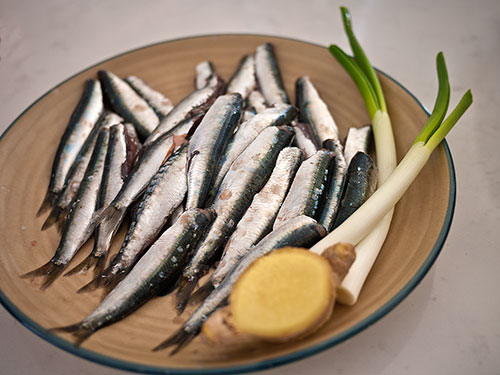
To deal with the sardines, position yourself at your sink and have a thin stream of water running out of the tap.
Take one of the sardines, and just run your thumb down the belly and pull it open. You'll see a bit of guts there; just pull it out and wash it off with the running water. (If you don't have access to running water, just use a bowl filled with clean water and swish the fish in it.)
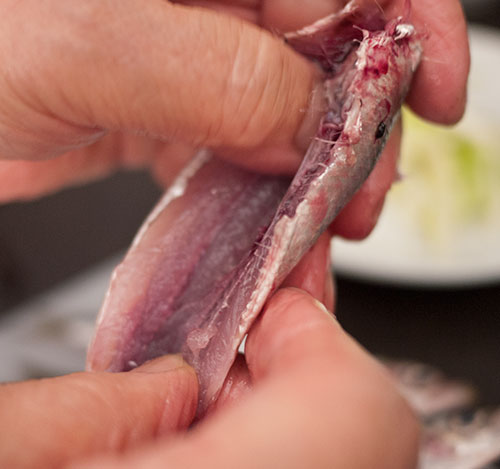
The next thing is to take out the bone. This comes off easily in one go. Pry it off at the head end, and just pull. Don't be hesitant. Give it a tug and it's gone, tail and all.
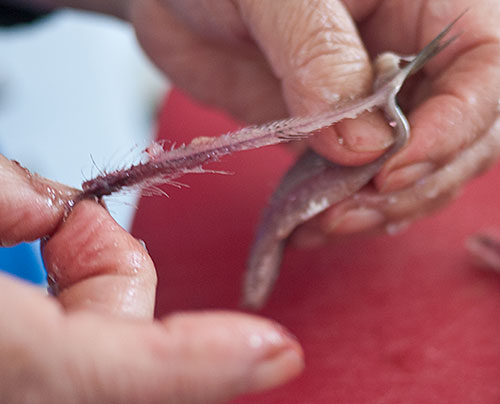
Don't throw away the bones by the way! Put them on a plate to deal with later.
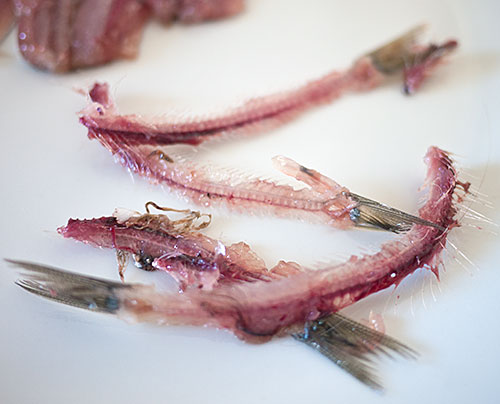
Here's the gutted and boned sardine - so easy! At this point, run your finger carefully down the surface of the fish. If you feel any little bones left in there (which you shouldn't if you ripped out the backbone properly) take them out with your fingernails or a pair of fish bone tweezers.
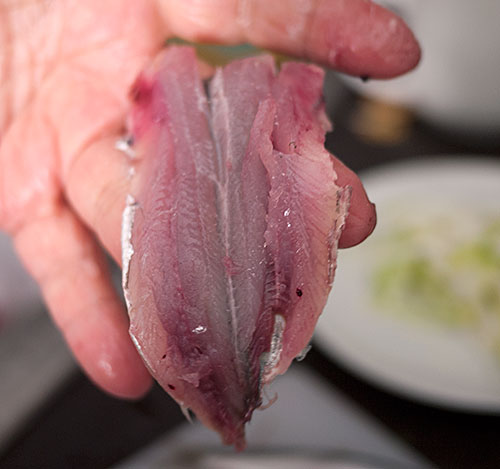
Here it is on the other side.

Wash each filet again to get rid of any stray bits of guts and stuff.

This next step is somewhat optional, but does improve the texture of your fish. The skin of the sardine peels off quite easily. Just pry up a corner with your thumbnail, and pull it off in one go. As with the bone, don't hesitate here or the skin will rip and it becomes harder to take it off.
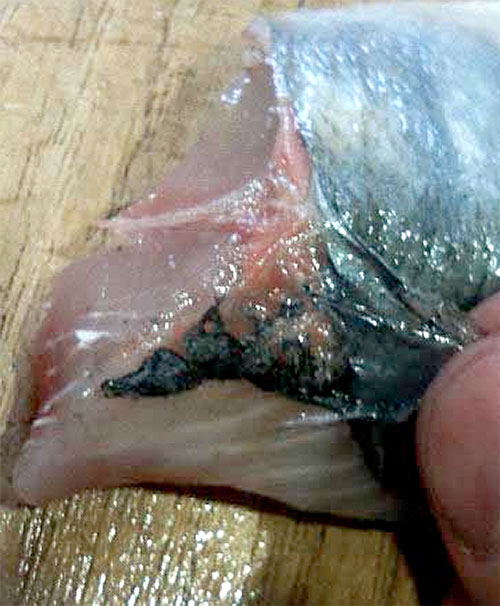
Here are the skinned filets. Put them on absorbent paper towels to drain off the excess water.
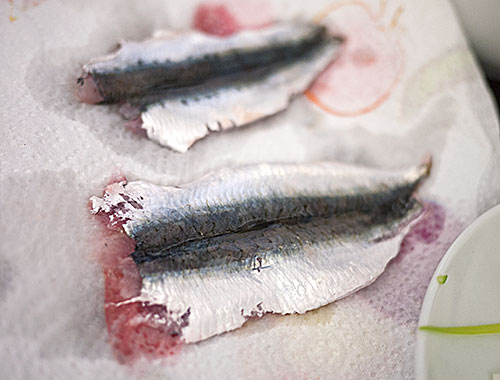
At this point you can pan-fry them in a bit of olive oil or butter (maybe coat them with flour or cornstarch first), or marinate them, or whatever you like to do with such fish. You can even turn it into sushi!
Recipes using fresh sardines
- Here is a classic way to use sardines, Iwashi no tsuire-jiru - Sardine balls in clear soup..
- A frugal way to use up the bones: Fishbone crackers


 Welcome to Just Hungry, where we serve authentic Japanese recipes and more! I'm
Welcome to Just Hungry, where we serve authentic Japanese recipes and more! I'm 













Comments
missmochi
26 April, 2013 - 05:09
Permalink
Re: Japanese Cooking 101, Lesson 5 - Fish, Part 3: How to ...
This is a great post! Even though I cook a lot of Japanese American/Hapa dishes at home, I've never been good about incorporating enough small oily fish even though they are so tasty, economical, and good for you. The cleaning process intimidated me, but this inspires me!
AndyT
26 April, 2013 - 15:49
Permalink
Re: Japanese Cooking 101, Lesson 5 - Fish, Part 3: How to ...
So what's with the bones being left sitting on a plate .. what are they for ? Or did I miss something ?
Sanya
26 April, 2013 - 17:56
Permalink
Re: Japanese Cooking 101, Lesson 5 - Fish, Part 3: How to ...
The sardines in the photo look so good...
It's a bit hard to find them here in the Boston area. Both the fresh and the frozen kind and much bigger than what I'm used to (I'm originally from eastern Mediterranean) and they don't taste as intense. I really wish I could eat them more often. Just reading this post makes me so happy. Most New Englanders around me don't seem to understand how I can enjoy small oily fish like sardines. Sometimes, if I'm lucky enough, I am able to find relatively decent sanma at the local Japanese market and I love those too.
Maybe if more people asked for them, more local markets would have them here. Thank you so much for this post and inspiring people to eat more of these delicious little fish!
Guruman
27 April, 2013 - 21:28
Permalink
Re: Japanese Cooking 101, Lesson 5 - Fish, Part 3: How to ...
This method really works like a charm…
cooking.eating....
2 May, 2013 - 06:06
Permalink
Re: Japanese Cooking 101, Lesson 5 - Fish, Part 3: How to ...
Maki,
I've been thoroughly enjoying your lessons, especially the fishy ones, I wish it could go on and on with more and more recipes. I've been buying whole fish more frequently these days, and always thinking up new creative ways to cook them. But I have never bought sardines before, small fish scare (in terms of preparing them). But I think I might give this a go, if I can find them fresh. And your sardine cracker is a brilliant idea!!